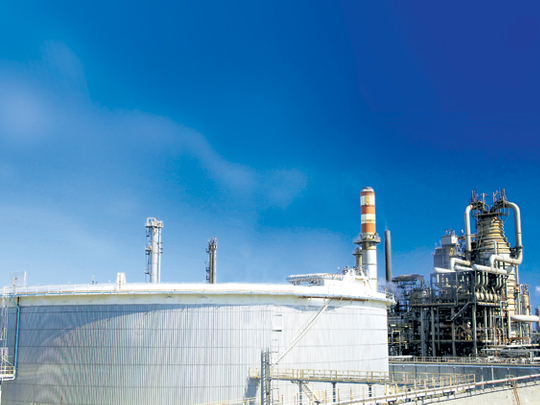
Dubai: Annual petrochemicals production of the Gulf states is expected to jump around 46 per cent to 155 million tonnes per annum by 2015, up from 105 million now, according to a latest report by the Gulf Petrochemicals and Chemicals Association (GPCA).
The region's current production represents about 16 per cent of the total 700 million tonnes worldwide petrochemicals output. By 2015, the Gulf states will contribute a fifth (20 per cent) of the global output, industry reports say.
"This could require potential investments to the tune of $55 billion (Dh201.85 billion) in the next five years," Dr Abdul Wahab Al Sadoun, Secretary General of the GPCA, told Gulf News.
"By then, the Gulf's petrochemicals industry will represent 20 per cent of the total global petrochemical output." The production of petrochemicals is growing at an annual compound growth rate of 12 per cent.
It is expected that by 2015 the production in this region of the polyethylene, polypropylene, PVC and polystyrene will double to reach more than 23.6 million tonnes in comparison to last year's figure of 13.5 million tonnes, a staggering 75 per cent increase.
Fertilisers absorb 28 per cent of the petrochemicals output while basic petrochemicals use 37 per cent, polymers sector absorb 20 per cent and the rest 15 per cent are used by intermediaries.
The Gulf region currently produces over 25 million tonnes of plastic resins annually out of which close to three million tonnes is converted into finished and semi-finished industrial and consumer plastic products.
Dr Sadoun said the Gulf has a geographical advantage in the global petrochemical business as it sits on the world's largest hydrocarbon resources while it is closer to the major petrochemical consumer base — Asian markets especially China, India and the Far East — that are becoming the largest consumers.
"Currently 55 per cent of the Gulf's petrochemicals are exported to China and the Far East," he said. "The GCC is becoming the centre of the global petrochemical business with Saudi Basic Industries Corporation (Sabic), Abu Dhabi Basic Industries Corporation (Adbic), Abu Dhabi Polymer Company (Borouge), Chemeyaat and the Chemical City in Abu Dhabi are going to be the world's leading petrochemicals players."
The hydrocarbon-rich Gulf states have historically been pumping crude which helps fuel global growth. However, since the 1970s, governments have been gradually developing refining capabilities and petrochemical sector that produces basic raw materials that are used as feedstock for plastics and associated industries.
Challenges
As a result, Sabic, Saudi Aramco, Adbic, Borouge and other major companies have evolved. The Abu Dhabi government last year announced the development of a $20 billion Chemical City that will help the UAE diversify from oil and help it to build a strong industrial base that will create jobs and enhance technological know-how.
As a result, Jubail Industrial City and Ruwais in Saudi Arabia are becoming major centres. Both Saudi Arabia and Abu Dhabi are investing billions of dollars in expanding output capacity.
However, the industry might face challenges regarading technology and shortages of local skills — an issue governments must address, Dr Sadoun feels. "Historically, the governments have used oil money to develop infrastructure and associated facilities. Now, the challenge will be to take it to the next level," he said.
"With the development of the petrochemical industries and chemical clusters, the governments have already taken that step," he said.
The next step going forward would be to let the private sector investment in industries that will use the petrochemicals as feedstock.
"Auto industries are the largest users of petrochemicals," he said.
He urged the government to do a proper assessment of the industry. "What we do need is good industry mapping. We are still a black box… little is known about the opportunities that add real value," he said.
"We believe the regional petrochemical sector, based on our coverage, will register quarter-on-quarter growth of 20.3 per cent and 23.1 per cent in sales revenue and net profit, respectively, in first quarter 2011," said a latest report by Global Investment House.
"The expected growth in the first quarter is mainly based on (1) the favourable prices of related products and (2) 12.3 per cent quarter-on-quarter growth in production volume. It is noteworthy that we are not expecting any major improvement in capacity utilisation, on back of slow economic recovery in European and US markets," Faisal Hassan, head of research at Global Investment House.
"Hence the expected volumetric growth is mainly based on the start of commercial operations from new plants of major players i.e. Industries Qatar and Sabic in first quarter 2011. Furthermore, we believe the expected improvement in the average prices and production growth will lead to offset the increase in expansion and operating costs."
Fast Facts: Saudis steal limelight
Saudi Arabia is the region's largest producer of petrochemicals, representing about 50 per cent of the region's total petrochemical output while Iran produces 27 per cent, Qatar exports 9 per cent. Among the rest, Oman and Qatar produces 5 per cent each while the UAE and Bahrain produce three and one per cent respectively.
The UAE currently produces 3.4 million tonnes annually, which is expected to more than double to 7.8 million, while Iran plans to raise production to 41.9 million by 2015, from the current level of 28.4 million. Saudi Arabia, the biggest producer, plans to raise output to 70 million by 2015 from the current production level of 53.2 million.












